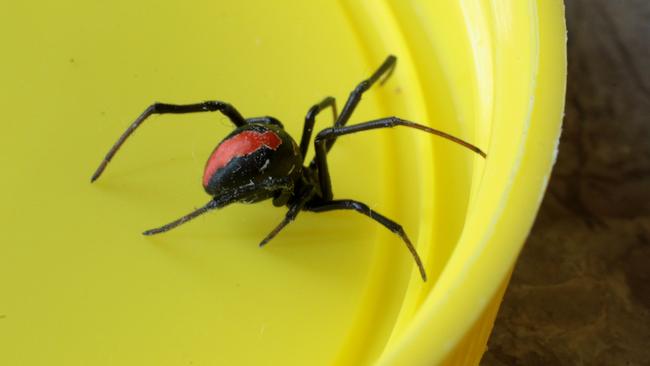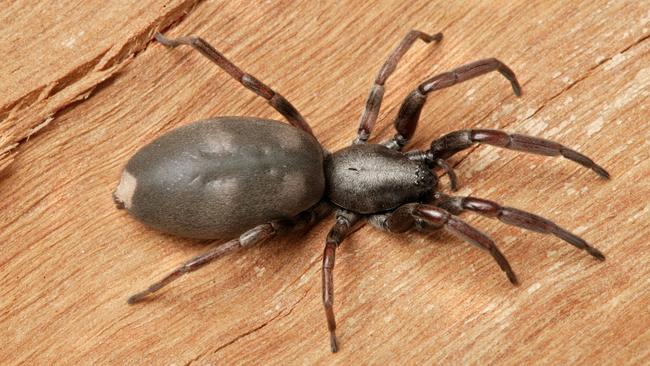Spider expert reveals the answers to your niggling redback questions
SOME of Australia’s most dreaded creatures are about to come out for the summer. This is what you should know ahead of time.
‘TIS the season for some of Australia’s most dreaded creatures, from snakes to spiders, to come out and play.
We’re especially warned to be on the lookout for potentially deadly redback spiders this summer, especially in Queensland, where four people have already survived redback bites.
Rain is to blame for the bumper season ahead, with years of drought having kept the arachnids at bay — until now.
And as more of them emerge from the wilderness and creep into our roofs, backyards and — if you have them — outdoor dunnies, many readers flooded the news.com.au Facebook page with questions about the much feared redback.
So we’ve caught up with redback expert Dr Robert Raven from the Queensland Museum for the lowdown.
Here are your questions with Dr Raven’s answers.
Do redbacks kill?
The issue with a redback bite, as with any spider bite, is how much venom you get. In some cases a bite can be just an offensive bite, a “let me go” or “go away” bite with no venom.
In one case a lady showed me a bump on her finger (from a redback bite) and that’s all that had happened. On the other hand, burly stockmen can be driven mad with pain. It very much depends on how much venom you get, and a spider can bite repeatedly — one woman was bitten up to seven times and needed 17 pills of anti-venom.
Redback venom does its action right on the spot — it doesn’t go off to the heart or anything. But somehow, 13 deaths have occurred from a redback bite, so it can kill and does kill. No deaths have occurred since the 1960s when the anti-venom was first released, except through anaphylaxis, which is the same thing that occurs with a bee sting or something, when someone has an allergy.

Are some people more susceptible to fatal bites than others?
Different people react in different ways, and certainly someone with a smaller body mass, like a child or an elderly adult, would have much susceptibility.
The biggest issue is that the young and those who have compromised skin conditions will either not be able to communicate or not know they have been bitten, so the bite can progress for a long time before anyone realises what it is.
How can we avoid getting redbacks in our houses?
The spiders love northern and western faces, because those are the sun exposure faces, but they don’t like plants. So shade and plants are good. Redbacks are most common in suburbs that have very few trees. They don’t like water — it won’t kill them, but they don't like it — and again the southern, shaded faces are of less concern. They need to get a bit of heat.
Where do they hide the most?
The biggest areas of concern, especially with children, are areas where sandpits or play areas are in the sun and toys are left out to heat up.
So playgrounds, toys, under chairs — anywhere where there’s shelter from the rain and exposure to the sun. Sunny barbecue spots are fantastic (for redbacks).
In the worst situations they get into the weep holes around brick houses and the bad ones are in the ceilings themselves ... and that generates problems because when it gets hot up there the spiders will fall down through the gaps and start invading the house.
If a car has been left out on the street it’s a perfect target, along with any metallic junk you have left lying around in the sun. These things are moving around on vehicles, especially vehicles that have been sitting around for a while, like emergency services vehicles that are only called out sporadically. In fact vehicles that are sitting for a long time in areas near where there is infestation will carry the infestation on.

It is only the females who bite?
It’s only the females that have really got enough size to bite. You wouldn’t really recognise the male — it’s just a tiny black spider, with a little white stripe on it and no red at all. It’s very rare you’ll see them — they look like a little speck of dust on the web. What we usually mistake for males is the young females, because they have a red stripe. The only validated bites are from females, or from young females.
What do you do if you get bitten?
The issue is contingent upon who you are and what you are. Young children and older people, as well as diabetic, asthmatic, allergy-prone people — those are all high risk people and they need to get to a doctor and have someone with them.
With a bite on a normally healthy person, all the hospital and doctors can do is wait to see whether or not it will go full-blown. That will mean you’re sitting there for three hours, hopefully with a book or something interesting to read on your phone. They’re not being rude; it’s just the only way they will know if anything’s going to happen and there’s nothing they can do in the meantime that will make it better or worse.
It’s usually not an ultra emergency situation (for usually healthy people) — you’d be advised to have someone with you for three hours and if you start showing symptoms of great distress they should send you to a doctor or hospital. It’s a watch-and-see situation.
Ice is what they recommend to ease the pain — but no restrictive bandages at all.
Aren’t white tail spiders even worse, and can you really use bleach to treat a white tail bite?
Wow! Bleach on any piece of the skin is not nice ... I wouldn’t recommend using bleach on human skin.
The issue with the white tail spider is entirely dismissed now. The (white tail) spider’s venom is totally uninteresting — it’s boring, it’s not even as nasty as a sandfly bite. White tail spiders have continually been misaccused of lots of different things and most of those things have nothing to do with a spider, much less a white tail spider — often they’re either bacterial or viral infections. The white tail spider is harmless.

Is it true that daddy long legs will keep your house redback-free?
There’s a war on between daddy long legs and redbacks. The daddy long legs won’t keep your house redback free as such, but the battle would be won by the daddy long legs in a combative situation.
BONUS REDBACK QUESTIONS
Given we’re in the business of asking questions, and we were on a roll with Dr Raven, we thought we’d sneak in a few questions of our own.
Why do we see so many redbacks at this time of year?
The thing is with these guys is that they’re dependent upon insect feed and during the winter there’s not much around. It’s even more lean pickings largely due to the Asian house geckos wiping a lot of (insects) out.
As the spring and summer comes in, we’ve been getting rain, which has been causing plant growth and therefore insect emergences, and therefore food. And thus the spider can grow.
How common are redback bites, really? And do you have to go out of your way to get bitten?
I think a lot of these bites go straight to hospitals and doctors, so we don’t hear of that many. I think the figure for Australia is around 5000 to 10,000 bites per year, and many of them are of minor consequence.
You do have to bother them (to get bitten), you have to stick your hand into their home. You might sit on your chair and try to move it forward, and stick your hand onto their home under the chair. Bites may happen when you’re putting your hands and feet in places where you cannot see.
What does a redback bite feel like?
The most diagnostic feature of a redback bite are the localised patches of sweating and severe pain. Other symptoms occur and they are of course very, very diverse, but those are the key ones.

What’s the best way to get rid of a redback in the house?
A good way is to take something like a rolled-up newspaper and squash it. Don’t slam it, squash it steadily. One of the things I recommend is squashing the spider and knocking all the web down carefully, and then checking that again that night. Because if somebody else (another spider) is up there, they’ll come down and rebuild the web so they can catch food, and that will happen in a few hours.
If you’ve had shoes outside, especially in a sunny spot, take a bit of newspaper, screw it up and slam it inside the shoe, really hard, and then shake the whole lot out. Even if you don’t kill the spider you’ll loosen it from its web and it will come out.
The thing to make sure you understand very clearly is that going after spiders in your roof cavity is not a job for you. It’s a very dangerous thing to do. Call a professional and get them to go up there.
I’ve been up in roof cavities when there are lots of redbacks around and it is frightening. What you can see in front of you is not what’s coming down the back of your neck and biting you. They’re all around, you’re bumping their webs and they’re dropping down and getting disturbed. It can be very dangerous.
Finally, are redbacks good for anything? For example, will a redback keep other nasties away?
No. Not at all. I would consider them a pest.
Queensland Health recommends anyone bitten by a redback who is allergic to redback venom, is pregnant, or who has heart disease, should see their doctor immediately.
All other patients should follow general first aid.




